
As a result, any anti-aliasing along the “snapped” edges of the object (usually the left and top edges) disappears. If you move, add, or transform an object, the object snaps to the pixel grid. You can view the pixel grid if you zoom in to 600% view. The placement of pixels is determined by the pixel grid that divides the artboard into 1‑point (1/72 inch) increments. To understand how Illustrator divides objects into pixels, open a file that contains vector objects, choose View > Pixel Preview, and magnify the artwork so that you can see its individual pixels. This is especially helpful when you want to control the precise placement, size, and anti-aliasing of objects in a rasterized graphic. You can preview how objects will appear when rasterized by choosing View > Pixel Preview. When you save artwork in a bitmap format, such as JPEG, GIF, or PNG, Illustrator rasterizes the artwork at 72 pixels per inch. With this property enabled, any new objects that you draw have the pixel-aligned property set by default.įor more information, see Drawing pixel-aligned paths for web workflows. Illustrator also provides the Align New Objects to Pixel Grid option at the document level, which is enabled by default for Web documents. You can enable this property by selecting the Align to Pixel Grid option from the Transform panel. On any transformation, as long as this property is set for the object, it gets realigned to the pixel grid according to its new coordinates. When the pixel-aligned property is enabled for an object, all the horizontal and vertical segments in the object get aligned to the pixel grid, which provides a crisp appearance to strokes. To enable web designers to create pixel accurate designs, the pixel-aligned property has been added in Illustrator. Print gradients, meshes, and color blends.Specify crop marks for trimming or aligning.Creative Cloud Libraries in Illustrator.Best practices for creating web graphics.Identify fonts from images and outlined text.Create shapes using the Shape Builder tool.Enhanced reshape workflows with touch support.Build new shapes with Shaper and Shape Builder tools.Draw pixel-aligned paths for web workflows.Draw with the Pen, Curvature, or Pencil tool.Troubleshoot Illustrator cloud documents issues.Troubleshoot create or save issues for Illustrator cloud documents.Illustrator cloud documents | Common questions.
#Zoom shortcuts ipad upgrade

Work with documents in Illustrator on the iPad.Keyboard shortcuts for Illustrator on the iPad.What you can or cannot do on Illustrator on the iPad.System requirements | Illustrator on the iPad.Introduction to Illustrator on the iPad.Microsoft Surface Dial support in Illustrator.


Switch to minimized window: Cmd+Shift+M.Toggle “Always Show Meeting Control Toolbar” On/Off: Ctrl+\.Toggle meeting controls On/Off: Ctrl+Opt+Cmd+H.Toggle In-Meeting Chat panel On/Off: Cmd+Shift+H.Toggle Participants panel On/Off: Cmd+U.Go to next video stream in Gallery: Ctrl+N.Go to previous video stream in Gallery: Ctrl+P.Toggle Active Speaker and Gallery views: Cmd+Shift+W.Share screen via Direct Share: Cmd+Ctrl+S.If you’re using Zoom on macOS, you can use all the following hotkeys: Toggle floating meeting controls: Ctrl+Alt+Shift+H.Pause/Resume Screen Share: Alt+T (only works when the meeting control toolbar is onscreen).Stop current Screen Share and launch a new one: Alt+S (only works when the meeting control toolbar is onscreen).Toggle Screen Share On/Off: Alt+Shift+S (only works when the meeting control toolbar is onscreen).



 0 kommentar(er)
0 kommentar(er)
